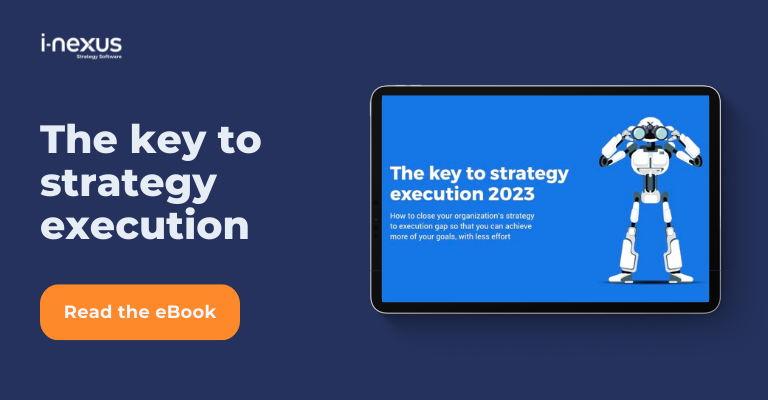We all know that what separates the market leaders from the pack is the ability to successfully plan their strategic direction and deploy this across the business - but what are the challenges that derail the best of plans? Find out.
Written by: James Milsom, Head of Marketing
In strategy, the journey is as important as the end goal.
Without a plan to achieve your strategic goals, and careful, effective execution of the said plan, your organization will likely fall short.
To meet your strategic goals with consistency, you must consider your planning and execution.
Every company has a strategy, but market leaders are defined by their ability to successfully deploy and execute their strategy.
Unfortunately, the success rates leave considerable room for improvement.
A high strategy failure rate
Just 56% of strategies are successful as reported by PMI.
Many fail at the deployment stage, and this has a negative impact on the bottom line and buy-in.
Organizations that don’t align their business model with their strategy report consistently poorer financial results than their peers.
The investment in Strategy Deployment should be equal to, if not more than, the effort allocated to strategy planning.
But, in The Balanced Scorecard, authors David Norton and Robert Kaplan note that 90% of organizations fail in Strategy Execution.
CSOs must critically evaluate their path of choice, and the execution associated with it if there proves to be no correlation to bottom-line value.
The effort spent on researching, devising, and producing a strategy is wasted too frequently.
Success is born by culture
A successful strategy is created through millions of ‘little wins’.
Sweating the small stuff pays off in the long term, as every individual component and stakeholder plays a huge role in your wider victory.
Strategy is usually driven by senior management.
Modern CSO and Heads of Strategy, however, recognize that every person contributes to meeting strategic goals.
In these organizations, performance is measured on an ongoing basis, decisions are aligned with the strategy, and efficiencies are optimized to achieve the best outcome.
An execution-oriented culture reigns supreme.
5 Strategy Deployment mistakes to avoid
Replicating the success of leading organizations isn’t inherently a difficult task. In fact, you can begin by avoiding the 5 Strategy Deployment mistakes that derail many organizations.
1) Failing to connect strategy to action
Market leaders have devised ways of bridging the gap between strategy and operations.
To ensure success, leadership must cascade a strategy to every business unit and employee, down to a project level.
This must be tracked constantly to ensure the strategy is on track and that people are working on the right things at the right time, and you can anticipate and execute pivots when needed.
Every action must drive the strategic plan.
It’s worth considering how you communicate a strategy to each business unit and department head.
Deployment becomes easier when key managers are invested in it.
Regular check-ins are essential, at least weekly, if not daily.
This is none-more evident when multiple programs are running, as this will reduce the risk of a project going off-track or being delayed.
Ford's approach to communication
Former Ford CEO Alan Mulally understood this need when he took over the helm of the automotive company.
He implemented a weekly BPR (Business Plan Review) process for his leadership team. Held at the same time every week, attendance at the meeting was mandatory.
Each leader had to deliver status reports and updates on their business areas, giving an early indication of any delays or problems.
Tracking performance in this way strengthened the bottom line and ensured the strategy was being executed.
2) Overlooking assumptions
Every strategy is based on a set of assumptions.
However, at best these are often ignored when a plan isn’t working, with managers forging ahead without a course correction. At worst, they are set in stone and not reviewed even in the face of uncertainty.
Once Strategy Execution is ruled out, double-check your underlying assumptions.
Keep every option open when considering how to improve your performance.
Forming diverse project teams can help question assumptions and undercover biases that might impact your strategy.
This also requires feedback mechanisms to allow for quick communication with senior leadership to rectify discovered assumptions.
Strategic Assumptions Surfacing and Testing
SAST (Strategic Assumptions Surfacing and Testing) can also be used to question, define and decide on assumptions. This five-phase process relies on the following principles:
- Adversarial: the best way to test an assumption is to oppose it.
- Participative: resources and knowledge are distributed among a group of individuals.
- Integrative: a unified set of assumptions and an action plan are needed for decision-making.
- Managerial mind supporting: exposure to the assumption deepens a manager’s insight into an organization and its strategy.
3) Poor program and portfolio governance
To reach a goal, you need to double-check your course and correct it when necessary.
The strategy must be conscientiously deployed, actively managed and its execution tracked.
Investing in dashboards, establishing common KPIs, leading indicators and regular reporting is critical. It will help with decision-making, accountability, confidence, and agility.
With your whole organization aligned, they can drive your strategy and connect their work to it.
Many organizations have become reliant on lagging indicators that fail to provide a full picture of performance.
Your strategy cannot go forward if your organization is constantly looking back.
Look for metrics that tell you where you’re going, such as the growth of your sales pipeline.
4) A lack of focus
Similarly, a lack of focus is a common strategy deployment mistake we’ve seen time and time again.
You must have the courage (and data) to end projects or initiatives that aren’t aligned with your strategy and that are holding you back.
Focus on what’s important and streamline your resources.
Assessing your programs and portfolios is a continuous endeavor.
Question how important each project is to your strategy and how well they are progressing.
Your success hinges on the performance of many projects - make sure you’re working on the right ones.
5) Relying on outdated technology and tools
The deployment and execution of your strategy cannot be seamless if it’s reliant on clunky spreadsheets, siloed data, and elbow grease.
Consider digitalizing your Strategy Deployment and make use of Strategy Execution software that can support you in ensuring that you deliver on your strategic needs and goals.
People are tired of seeing endless presentations, spreadsheets and emails.
It’s demotivating, slow, and laborious to manage projects through these channels, and important information can be rapidly buried.
Since reporting on progress using these tools is a very manual process it is difficult to stay ahead and understand where the real problems lay.
Strategic planning and strategy execution software, such as i-nexus, can quickly surface relevant information such as project timelines and delays, KPIs, critical problems, and goal performance.
Allowing key stakeholders to see relevant information as and when needed.
Automation also removes a considerable amount of legwork from deploying your strategy, enabling you to focus on its deployment and, ultimately, its execution.
Not to be underestimated
The mechanics of strategy deployment are straightforward when your team, business, and information are aligned. Focusing on these areas is as important as your strategic planning.
Developing an effective strategy will start your organization off well.
Taking a considered approach to strategy deployment will power the rest of your journey.
Don’t underestimate its contribution to your success.
What are the next steps?
The five strategy deployment mistakes detailed in this blog provide a small sampling of the issues surrounding successful Strategy Execution, but this is only one piece of the puzzle.
To gain a wider understanding of strategy deployment, visit our resource hub, or any of the below:
- Hoshin Kanri strategic planning template set: Plan, execute, and track your Hoshin with this Excel pack.
- How AI and machine-assisted learning will help your Strategy Execution: As Artificial Intelligence becomes a mainstay in our lives, read how AI and machine-assisted learning will evolve to support your Strategy Execution.
- Download our Key to Strategy Execution eBook: Read how companies like Danaher and HP have mastered Strategy Execution Management and what you can learn from them.
About the author
James Milsom is Head of Marketing at i-nexus. James has wide-ranging experience in markets such as telecommunications, energy, education, and software.
As Head of Marketing, his drive is to raise awareness and understanding of the challenges facing enterprises in delivering strategic objectives and transformation amidst changing markets and the obstacles traditional tools and methods present leaders.
If you’d like to talk more about Strategy Execution, reach out to James on james.milsom@i-nexus.com or connect with him on LinkedIn for the latest insights.




